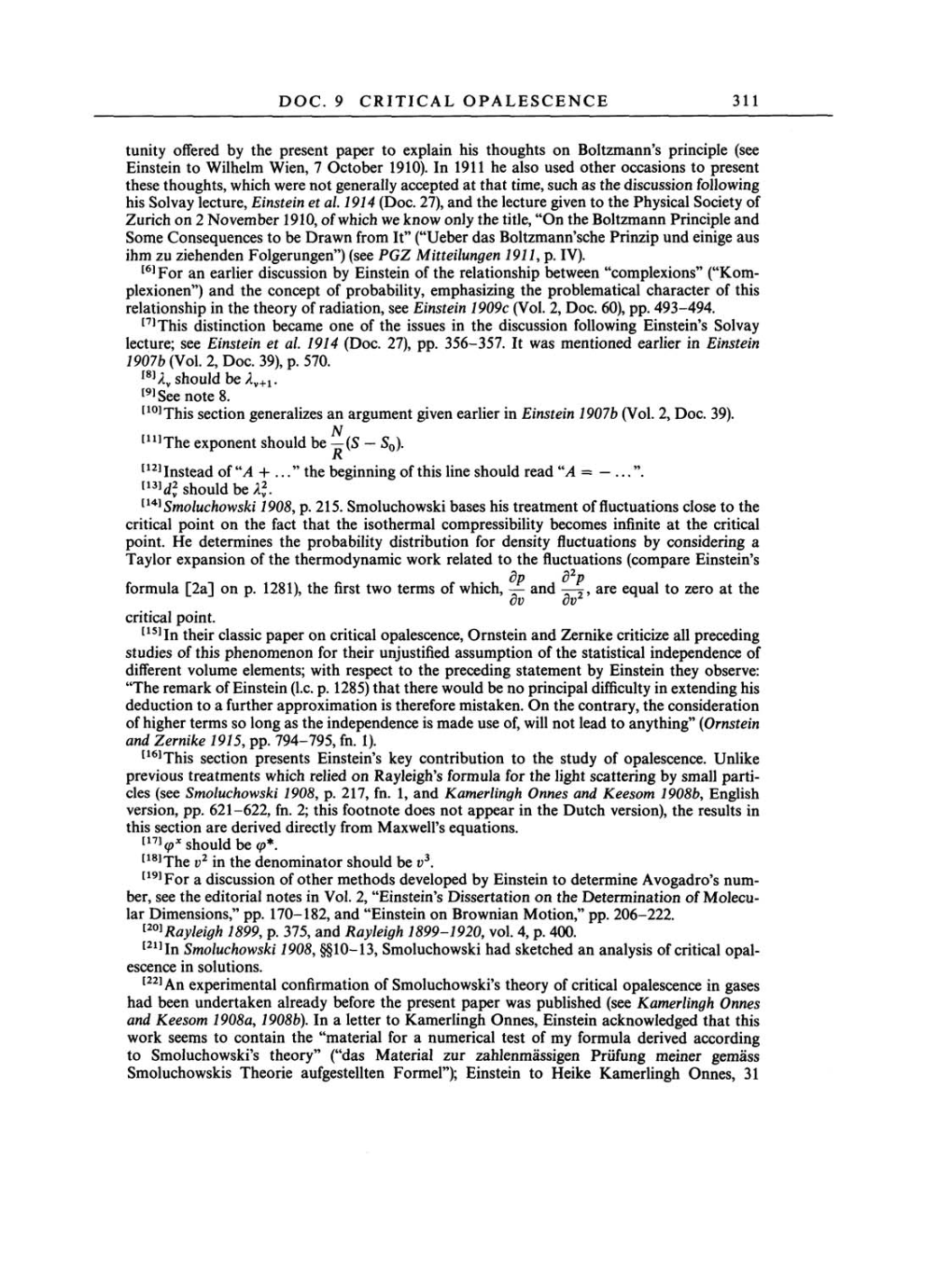DOC.
9
CRITICAL OPALESCENCE
311
tunity
offered
by
the
present paper
to
explain
his
thoughts on
Boltzmann's
principle (see
Einstein
to
Wilhelm
Wien,
7
October
1910).
In
1911
he also
used other
occasions to
present
these
thoughts,
which
were
not generally accepted at
that
time,
such
as
the discussion
following
his
Solvay lecture,
Einstein
et
al. 1914
(Doc. 27),
and the lecture
given
to
the
Physical
Society
of
Zurich
on
2
November
1910,
of
which
we
know
only
the
title,
"On the Boltzmann
Principle
and
Some
Consequences
to be
Drawn from It"
("Ueber
das Boltzmann'sche
Prinzip
und
einige
aus
ihm
zu
ziehenden
Folgerungen")
(see
PGZ
Mitteilungen 1911,
p. IV).
[6]For
an
earlier
discussion
by
Einstein of the
relationship
between
"complexions" ("Kom-
plexionen")
and the
concept
of
probability, emphasizing
the
problematical
character of this
relationship
in
the
theory
of
radiation, see
Einstein
1909c
(Vol.
2,
Doc.
60),
pp.
493-494.
[7]This distinction became
one
of the
issues in
the discussion
following
Einstein's
Solvay
lecture;
see
Einstein
et
al. 1914
(Doc. 27),
pp.
356-357. It
was
mentioned earlier
in
Einstein
1907b
(Vol. 2,
Doc.
39), p.
570.
[8]Av
should be
Av+1.
[9]See
note
8.
[10]This
section
generalizes
an
argument
given
earlier
in
Einstein
1907b
(Vol.
2,
Doc.
39).
[11]The
exponent
should be
N-R(S -
S0).
[12]Instead
of
"A +
..."
the
beginning
of
this line
should read
"A
=
-
...".
[13]d2v should be
A2v.
[14]Smoluchowski
1908,
p.
215.
Smoluchowski bases
his treatment
of fluctuations
close to
the
critical
point on
the
fact
that
the isothermal
compressibility
becomes infinite
at
the critical
point.
He determines the
probability
distribution for
density
fluctuations
by considering
a
Taylor
expansion
of the
thermodynamic
work related
to
the fluctuations
(compare
Einstein's
formula
[2a] on
p. 1281),
the
first two terms
of
which,
dp-dv
and
d2p-dv2,
are
equal
to
zero
at
the
critical
point.
[15]In their classic
paper
on
critical
opalescence,
Ornstein and Zernike criticize
all
preceding
studies
of
this
phenomenon
for their
unjustified assumption
of
the statistical
independence
of
different volume
elements;
with
respect to
the
preceding statement
by
Einstein
they observe:
"The remark
of
Einstein
(l.c. p.
1285)
that
there would be
no
principal
difficulty
in
extending
his
deduction
to
a
further
approximation
is
therefore mistaken. On the
contrary,
the consideration
of
higher terms
so
long
as
the
independence
is made
use of,
will not
lead
to anything"
(Ornstein
and Zernike
1915,
pp. 794-795, fn.
1).
[16]This section
presents
Einstein's
key
contribution
to
the
study
of
opalescence.
Unlike
previous
treatments
which relied
on
Rayleigh's
formula for the
light scattering
by
small
parti-
cles
(see
Smoluchowski
1908,
p.
217,
fn.
1,
and
Kamerlingh
Onnes and Keesom
1908b,
English
version,
pp.
621-622, fn.
2;
this footnote does
not
appear
in
the Dutch
version),
the results
in
this
section
are
derived
directly
from Maxwell's
equations.
[17](px should
be
cp*.
[18]The
v2
in
the denominator should
be
v3.
[19]For
a
discussion of other methods
developed
by
Einstein
to
determine
Avogadro's
num-
ber,
see
the editorial
notes
in
Vol.
2,
"Einstein's Dissertation
on
the Determination of
Molecu-
lar
Dimensions,"
pp.
170-182,
and "Einstein
on
Brownian
Motion,"
pp.
206-222.
[20]Rayleigh
1899,
p.
375,
and
Rayleigh
1899-1920, vol.
4,
p.
400.
[21]In
Smoluchowski
1908, §§10-13,
Smoluchowski had sketched
an analysis
of
critical
opal-
escence
in
solutions.
[22]An
experimental
confirmation of Smoluchowski's
theory
of critical
opalescence
in
gases
had been undertaken
already
before the
present paper
was
published
(see
Kamerlingh
Onnes
and Keesom
1908a, 1908b).
In
a
letter
to Kamerlingh Onnes,
Einstein
acknowledged
that this
work
seems
to
contain the "material for
a
numerical
test
of
my
formula derived
according
to
Smoluchowski's
theory" ("das
Material
zur
zahlenmässigen Prüfung
meiner
gemäss
Smoluchowskis Theorie
aufgestellten
Formel");
Einstein
to
Heike
Kamerlingh Onnes,
31
